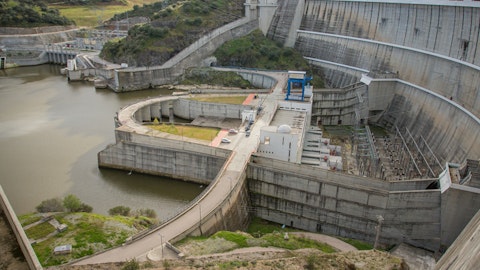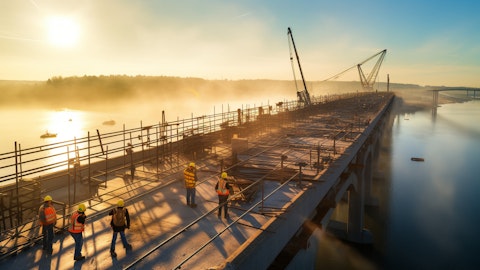Construction Partners, Inc. (NASDAQ:ROAD) Q1 2024 Earnings Call Transcript February 9, 2024
Construction Partners, Inc. beats earnings expectations. Reported EPS is $0.1877, expectations were $0.13. Construction Partners, Inc. isn’t one of the 30 most popular stocks among hedge funds at the end of the third quarter (see the details here).
Operator: Greetings, and welcome to the Construction Partners First Quarter 2024 Results Conference Call. At this time, all participants are in a listen-only mode. A brief question and answer session will follow the formal presentation. [Operator Instructions] As a reminder this conference is being recorded. It is now my pleasure to introduce your host, Rick Black, Investor Relations. Thank you, sir. You may begin.
Rick Black: Thank you, operator, and good morning, everyone. We appreciate you joining us for the Construction Partners call to review first quarter results for fiscal 2024. This call is also being webcast and can be accessed through the audio link on the Events and Presentations page of the Investor Relations section of constructionpartners.net. Information recorded on this call speaks only as of today, February 9, 2024. Please be advised that any time-sensitive information may no longer be accurate as of the date of any replay listening or transcript reading. I would also like to remind you that the statements made in today’s discussion that are not historical facts, including statements of expectations or future events or future financial performance are considered forward-looking statements made pursuant to the safe harbor provisions of the Private Securities Litigation Reform Act of 1995.
We will be making forward-looking statements as part of today’s call, that by their nature are uncertain and outside of the company’s control. Actual results may differ materially. Please refer to our earnings press release for our disclosure on forward-looking statements. These factors and other risks and uncertainties are described in detail in the company’s filings with the Securities and Exchange Commission. Management will also refer to non-GAAP measures, including adjusted EBITDA. Reconciliations to the nearest GAAP measures can be found at the end of our earnings press release. Construction Partners assumes no obligation to publicly update or revise any forward-looking statements. And now I would like to turn the call over to Construction Partners’ CEO, Jule Smith.
Jule?
Jule Smith: Thank you, Rick, and good morning, everyone. Joining me on the call today are Greg Hoffman, our Chief Financial Officer; and Ned Fleming, our Executive Chairman. We are off to a good start to our fiscal year, and I’d first like to thank our 4,400 employees throughout the Southeast for their hard work and professionalism, that contributed to a successful first quarter. Revenue, net income, earnings per share and adjusted EBITDA were all up significantly compared to Q1 last year. We are pleased to report a record backlog of $1.62 billion as of quarter end, reflecting a demand environment that remains strong for both public and private work. This first quarter, we experienced typical seasonal weather with October and November a bit drier than usual while December was a bit wetter than usual.
Our crews and teams were productive and delivered excellent results this quarter. Focusing more on the demand environment for construction services, there continues to be elevated demand for road repair, maintenance and expansion projects across our markets as a result of our country’s continued migration soil. Each of our 6 states are well funded for this work. With the federal government’s IIJA funding further supporting infrastructure investments from road projects to airports to ports and rail lines. Because of the migration to the Sunbelt of both new residents and businesses, the commercial economic activity in our markets has remained steady with an active bidding environment. We anticipate that our work mix for FY ’24 will remain very similar to last year and typical for CPI, with approximately 63% public projects and 37% private projects.
Turning now to CPI’s strategic growth model. In this fiscal year, we’ve so far completed 4 strategic acquisitions, entering new markets, expanding market share in existing markets and adding capacity, services and talented new team members to the CPI family. Most recently, we announced on January 3 the acquisitions of SJ&L General contractor, a hot mix asphalt and site work company headquartered in Huntsville, Alabama and Littlefield Construction Company, a soil base, surface treatment and site work company headquartered in Waycross, Georgia. As we discussed in detail during our Analyst Day, a key component of our growth strategy is to actively expand our relative market share and service capabilities within existing markets. Both the SJ&L and Littlefield acquisitions expand our service offerings in existing markets while also adding valuable crews and equipment.
In the case of SJ&L in Huntsville, Alabama, we are integrating this team with our existing platform company in the state, Wiregrass construction company. The greater Huntsville metro area and interstate 65 corridor continue to experience tremendous growth and as a combined organization, we can now offer turnkey services, spanning the construction value chain on both private and public project opportunities within this market. Likewise, our Georgia platform company, the Scrubs Company entered the Waycross market just a few months ago through the establishment of a greenfield hot mix asphalt plant. Now having acquired Littlefield, we are even better positioned to capitalize on the market that reaches from the Port of Brunswick into South Central Georgia.

We are pleased to expand our presence in these crucial growth markets and proud to welcome the employees of SG&A and Littlefield into our continually growing CPI family. We continue to have numerous and active conversations with potential sellers, both inside and outside of our current states. The universe of potential opportunities in our highly fragmented industry is substantial. However, we remain patient and focused on finding the best strategic acquisitions that expand our footprint, increase capacity, grow relative market share and fit well within our CPI culture. We believe CPI is seen as the buyer of choice for many owners in the Southeast due to our reputation for treating sellers fairly, providing attractive career opportunities for their employees and our track record for successfully integrating and growing companies.
As we continually discuss with the market, CPI’s founding strategy has 3 main components: first, to operate a high relative market share business in local markets, building low-risk, high-margin projects from repeat customers and generating strong free cash flow; second, to capitalize on the need for the nation and our states to invest in catching up on deferred infrastructure maintenance and capacity. And third, as our industry goes through a generational consolidation to be the leader in building a scalable business by acquiring businesses in our industry. Our 5-year strategic plan that we call ROAD-Map 2027 simply outlines our plan to continue implementing CPI strategy. With growth targets that represent annual revenue growth of 15% to 20% and EBITDA margins in the range of 13% to 14% by 2027.
The foundation of our strategic plan remains our people. We plan to continue building a competitive advantage through our workforce, maintaining our organizational culture as a family of companies and providing superior benefits and career opportunities, which attract and retain the best construction professionals. At CPI, we are dedicated to building better lives and to building the infrastructure that keeps our communities connected. In summary, we are pleased after Q1 to be right on track with our plan. As we enter the second quarter of our seasonal business, where we are hard at work, maintaining our fleet and asphalt plants and preparing for the busy work season ahead in the spring and the summer. I’d now like to turn the call over to Greg.
Greg Hoffman: Thank you, Jule, and good morning, everyone. I’ll begin with a review of our key performance metrics for the first fiscal quarter compared to the fiscal first quarter in 2023. Revenue was $396.5 million, up 16%. The increase included $29.6 million of revenue attributable to acquisitions completed during and subsequent to the 3 months ended December 31, 2022, and an increase of approximately $25.1 million of revenue in the company’s existing markets, contract work and sales of HMA and aggregates to third parties. The mix of total revenue growth for the quarter was approximately 7.3% organic revenue and approximately 8.7% from recent acquisitions. Gross profit was $51.9 million or 13.1% of revenue compared to $30.5 million or 8.9% of revenue in Q1 2023.
General and administrative expenses were $36 million and as a percentage of revenue, were 9.1% compared to 8.7% in the same period last year. Net income was $9.8 million and diluted earnings per share were $0.19 up from $1.9 million and diluted earnings per share of $0.04 in the same quarter last year. Adjusted EBITDA was $40.9 million, an increase of 50.4%. Adjusted EBITDA margin for the quarter was 10.3% compared to 8% in the first quarter last year. You can find GAAP to non-GAAP reconciliations of net income and adjusted EBITDA financial measures in today’s earnings release. In addition, as Jule mentioned, we are reporting a record project backlog at of $1.62 billion at December 31, 2023, up from $1.6 billion at the end of our Q4 fiscal year 2023.
Turning now to the balance sheet. We had $68.7 million of cash and cash equivalents and $154 million available under the credit facility, net of a reduction for outstanding letters of credit. In addition, we have the ability to establish an incremental revolving credit facility up to the greater of $200 million or total trailing 12 months adjusted EBITDA. We have $280 million of principal outstanding under the term loan and $163 million outstanding under the revolving credit facility. The availability on our credit facility and cash generation will continue to provide flexibility and capacity to allow for potential near-term acquisitions and high-value growth opportunities. As of the end of the quarter, our debt to trailing 12 months EBITDA ratio was 1.78 times.
Our expectation is the leverage ratio will maintain a range of 1.5 times to 2.5 times while continuing to add sustained profitable growth. Cash provided by operating activities was $60.4 million compared to the $28.9 million in the same quarter last year. Net capital expenditures in the first quarter were $24.3 million. We expect net capital expenditures for fiscal 2024 to be in the range of $90 million to $95 million. This includes maintenance CapEx of approximately 3.25% of revenue, with the remaining amount invested in high-return growth initiatives. Today, we are maintaining our previously disclosed fiscal year 2024 outlook. We expect revenue in the range of $1.75 billion to $1.825 billion, net income in the range of $63 million to $70 million; and adjusted EBITDA in the range of $197 million to $219 million, which reflects adjusted EBITDA margin in the range of 11.3% to 12%.
And with that, we are now ready to take your questions. Operator?
Operator: [Operator Instructions] Our first question comes from the line of Kathryn Thompson with Thompson Research Group. Please proceed with your question.
See also 20 States That Have America’s Strongest Unions and 16 Countries Where It’s Easy to Get a Job as an American.
Q&A Session
Follow Construction Partners Inc.
Follow Construction Partners Inc.
Kathryn Thompson : I just wanted to focus into end markets. And first with the DOT work this quarter was 37% versus 33% in Q1 for the last 2 years. But the public contribution overall in Q1 was slightly lower than the previous quarters at 59% versus 61%. So it just seems that public non-DOT work was a lower contributor to this quarter. Is there anything to call out on the municipal level that could be driving this? Or any other color just to account for the delta?
Jule Smith: No, Kathryn. I don’t think so. We did a lot of public work that’s city, counties and DOTs and — so the mix of what we’re doing on public work in any one quarter can vary. But there’s nothing particular that’s changed about that. We do anticipate this year, as we said in the prepared remarks that our mix of work will be about 63% public and 37% private. In the public work, cities, counties, DOT and airports, different — they’ll all play a part in that public mix.
Kathryn Thompson : And then on the private side, all our channel checks still point to manufacturing, heavy industrial still strong and some edges of weakness continuing it for traditional office and shopping centers. Can you touch more on current trends you’re seeing on the private side and how the type of work for heavy versus light is differing from any trends you’re seeing in highway work.
Jule Smith: Yes, I think you’re exactly right with what you said, Kathryn. What we’re seeing is that as businesses continue to migrate to the Southeast as they reshore, we’re seeing a lot of manufacturing facilities get built, headquarters buildings, pharmaceutical manufacturing sites. That’s a lot more of what we’re bidding on. We do continue to see residential stay very steady. But there’s not as many office buildings and retail buildings in the mix, but there’s a lot more of the, as you would say, the heavy commercial sites.
Kathryn Thompson : And then final question just is more on we’ve seen some abatement of raw materials, but there are other costs that are going up. What are you seeing from DOTs and other contractors in terms of bidding expectations around input cost, and are there any other type of costs like insurance that are preventing projects from moving forward.
Jule Smith: I would say, Kathryn, clearly, inflation our DOTs have had to adjust their estimates to match the reality of the input costs that are out there in the marketplace. And I think they’re doing that. We’re seeing their estimates go up to where projects aren’t getting held up. It has affected their purchasing power to some extent. But there’s still a lot of things being bid, and I don’t see projects getting held up by that. I think they’re adjusting to the new world of input costs. I think that inflation is — continues to be steady. It’s not out of hand like it was a couple of years ago. But I think the DOTs, by and large, are keeping up with that in their outlooks and their estimates.
Operator: Our next question comes from the line of Tyler Brown with Raymond James. Please proceed with your question.
Tyler Brown: So it sounds like in Q1, weather was fairly normal. Just any thoughts here on Q2 for weather? I know it’s been off to maybe a rough start here in Q2. Just anything to think about there.
Jule Smith: Well, January has been cold, at least the first couple of weeks with the polar vortex. But the reality is, Tyler, we have expectations in our seasonal business. Q1, we expect October to be great, and it was. We expect December to be wet and it was. And so it was typical. We expect January to not be great weather. That’s when we’re fixing our equipment, as I said. And so we’re just getting ready for the work season. So we were able to work where we could in January and — but it definitely was pretty cold in a lot of places.
Tyler Brown: And then, Greg, just so I have it for modeling, but at the midpoint of the revenue guide, I think it’s calling for something like a mid-teens revenue growth. But just can you remind us how much of that is from expected M&A?
Greg Hoffman: Yes, you’re right. It’s 15% with the projected midpoint from last year. It’s going to be typical to what it was in the first quarter, about half and half equal percentage organic and inorganic — and that’s probably in the range of $125 million, $130 million of acquisitive revenue.
Tyler Brown: And then, Joel, so I know that M&A has been a driver since we’re talking about it. But you seem to have had a lot of success with greenfields. And I’m just curious if that will become bigger part of, call it, the external growth story in coming years. And if we just take Waycross as an example, how does establishing a greenfield hot mix plant in a new market drive discussions around additional M&A?
Jule Smith: Tyler, good question. Greenfields have always been one of our growth strategies where we see an opportunity to go to an adjacent market. And Waycross was just a perfect example of seeing an opportunity in an adjacent market for the Scrubs company to go put a hot mix asphalt plant. And that really led to the discussion with the Littlefield company about acquiring their business and bringing their workers and their equipment into that area, that Waycross the area. So once we establish a greenfield and we’re in an area that does provide opportunities for us to try to build market share in that market. And you’re right, Waycross was a perfect example of that. So greenfields are sometimes the answer, sometimes an acquisition to move into an area of the answer, but we’re studying all of them.
Tyler Brown: Just real quickly, Jule, kind of conceptually backlogs are strong. It feels like work is picking up on the public side. You look at a lot of private companies. I’m assuming they are effectively full as well. So I’m just curious if your internal metrics, however you measure them. Are you seeing fewer bidders or more rational bidding for public work given that, let’s say, the market is just generally full?
Jule Smith: Well, I would say, Tyler, yes, to a certain degree, people have good backlogs and the construction industry has a lot of work. Still a competitive bidding environment, but I would say, yes, there’s probably due to everyone having a lot of work. There’s probably fewer bidders, and I think that’s the sign of a healthy market.
Tyler Brown: My last one here, Greg, just kind of coming back to the model. I know that there was a gain on the Bluewater Facility Exchange last Q1. But just any broad thoughts just from a modeling perspective, how we should think about gains on sale per quarter? Is it maybe $1 million or something like that? Just any help would be there?
Greg Hoffman: Yes. I think that’s right from a modeling standpoint, yes. That was certainly a one-off I think every year, gain on sale of equipment is part of our strategy related to owning operating and then acquiring replacement. So yes, that’s — I would say that’s a pretty good number.
Operator: Our next question comes from the line of Andy Wittman with Baird. Please go ahead.
Andy Wittmann: I guess I was going to start out just by digging into the margins in the quarter a little bit. Maybe I’ll start with the G&A margins here. The raw number was up a decent amount, about $3 million or so above kind of where the run rate has been in the last few quarters. And so Greg, I was wondering if you could just comment on that. Is there anything in that number that makes it unusually high or low. You kind of did some more acquisitions, so I thought maybe there’s some deal costs in there or something else. But you tell us, is this the new run rate? Or is there something different from that we should expect?
Greg Hoffman: I think this is about what we would expect. We — if you compare to last year, we talked a little bit about there was still some $50 million worth of low gross margin work that we had to complete. And so now that we’re into fiscal ’24, we’re not seeing those. But in terms of overhead and acquisitions, we were slightly up this year — this quarter compared to last year. But I think what you’re seeing there is individual expenses that maybe were out of period, but we’re still expecting the year to turn out to be what we expected.
Andy Wittmann: Can you just remind us what it was that you expected for the year in G&A?
Greg Hoffman: Yes, 8%.
Andy Wittmann: And then just on gross margins. Obviously, you’re starting to get some of the recovery with your backlog now being better priced and inflation coming down, Jule. Can you maybe talk about how this quarter reflects. Are we now at the run rate where you kind of feel like the price/cost dynamics are kind of fully behind you and you’re operating at the gross margins that you expect? And maybe if you could just expand on that also by talking about how the expectations of the gross margins in the backlog that you’ve recently won compared to what you’ve been putting up here this quarter and the last few quarters?
Jule Smith: Yes, Andy, I think that’s exactly right. I mean I think just as we said in the summer, it’s just really back to normal for CPI. And I think that’s what you saw this quarter. If you remember, last year in the first quarter, we said we’re finishing up a lot of this pre-inflationary backlog because a lot of the projects we do finish in the October, November, December time frame, they get final paving. And so last year’s first quarter, we were just finishing a lot of that work. So what you’re seeing this quarter is really just us back to normal, doing work that has the costs baked in. And so it’s very much just a normal business. And I would say we’re adding backlog to — we’re adding work to backlog at healthy margins.
We’re seeing that our crews and our teams in all the areas are going out there and finding ways to win on projects, which is very much back to the norm. Of CPI, where more projects finish at better than bid margin. And so to us, it’s really just getting back to the normal operating model of CPI.



